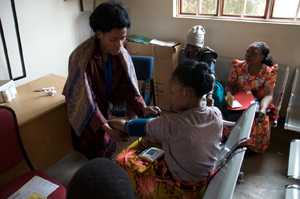Integrating HIV and hypertension management to improve lives in Malawi

Screening patients for hypertension at a clinic in Malawi.
Photo credit: Victor Balaban.
Malawi: A perfect storm
The landlocked country of Malawi, which is among the smallest countries in Africa, has one of the highest HIV prevalence rates in the world (10.3 percent of the population). It is also estimated that 33 percent of Malawians aged 25-64 years old have high blood pressure, which is a leading risk factor for cardiovascular diseases including heart attack and stroke. The President’s Emergency Plan for AIDS Relief (PEPFAR) was responsible for the rapid growth of anti-retroviral therapy (ART) clinics in Malawi, which have provided life-saving ART treatment to over 600,000 HIV patients throughout the country. However, while costs are low for routine blood pressure screening during clinical visits, the health system in Malawi was not routinely offering these services. CDC and national partners saw an opportunity to leverage the strong public health infrastructure that had been established through PEPFAR to address both diseases.
“One-stop-shop” for hypertension and HIV
Working alongside Malawi’s Ministry of Health (MOH), the Lighthouse Trust, a national provider of HIV services, and Baobab Health Trust, a local non-governmental organization (NGO), CDC began a program to integrate blood pressure screening and treatment into existing PEPFAR-supported HIV clinics.
The blood pressure screening and management pilot project was introduced in two Lighthouse clinics in February 2015. To avoid disrupting clinic activities and ensure a manageable workload, the project gradually added different age groups of patients (>20-60+ years old) to the blood pressure screening program. The clinics started using a standardized electronic protocol for hypertension treatment among persons living with HIV (PLHIV). The protocol gives clinicians consistent guidance on how to prescribe medications for both HIV and hypertension to avoid side-effects and improve clinical outcomes of both diseases.
Baobab Health Trust took the project to the next level by adding a hypertension section to the existing electronic medical record system (EMRS). This helped medical staff make more informed medical decisions, and may allow the program to expand to other Malawi clinics in the future because the module is compatible with the national EMRS.
In just 18 months, the program has given blood pressure screenings to over 29,000 people in two clinics. More women (17,565) were screened than men (11,794), but hypertension prevalence was higher among men (16%) than women (9%). Eleven percent of those screened were newly diagnosed with hypertension and 85% of those with hypertension received treatment following the protocol guidelines. The total cost of hypertension treatment per person was less than five US dollars per year. Despite the project’s success integrating hypertension screening and management into routine HIV service delivery, expansion is challenging because of difficulties getting proper medications.
Spreading solutions
As a result of this project, Malawi’s hypertension treatment guidelines were revised to allow for hypertension treatment options specific for PLHIV. Within and beyond Malawi, there is a growing recognition of opportunities to integrate NCDs into existing HIV service platforms. Just this year, members of the global health community met to develop recommendations for linking HIV and NCD services on a global scale. The case study of Malawi shows what is possible. But greater support at all levels is needed to maintain these results and expand the program.
This project was made possible by strong partnerships with Malawi (the Malawi MOH, the Lighthouse Trust, and the Baobab Health Trust), and CDC (CDC Malawi, the Division of Global HIV and TB, the Division of Heart Disease and Stroke Prevention, and the Division of Global Health Protection).
To stay in the know about global HIV and TB, please subscribe.
- Page last reviewed: December 6, 2016
- Page last updated: December 6, 2016
- Content source:


 ShareCompartir
ShareCompartir